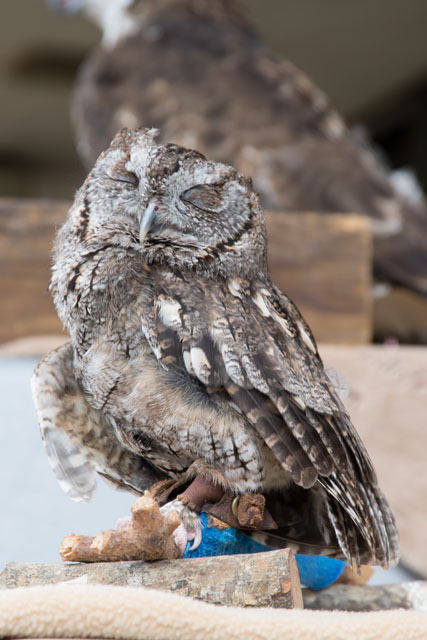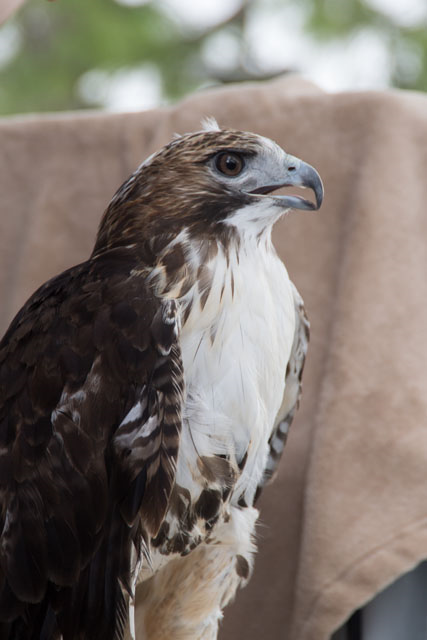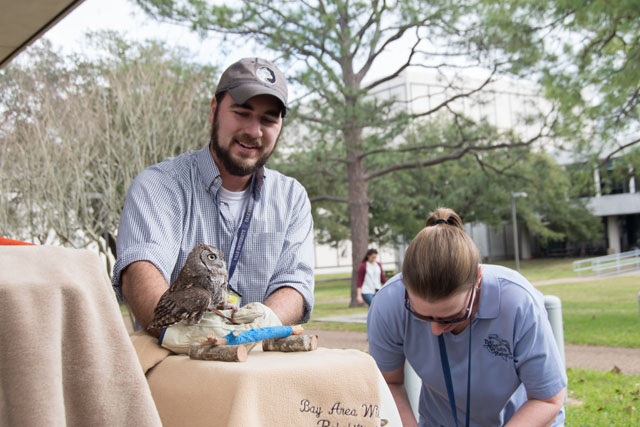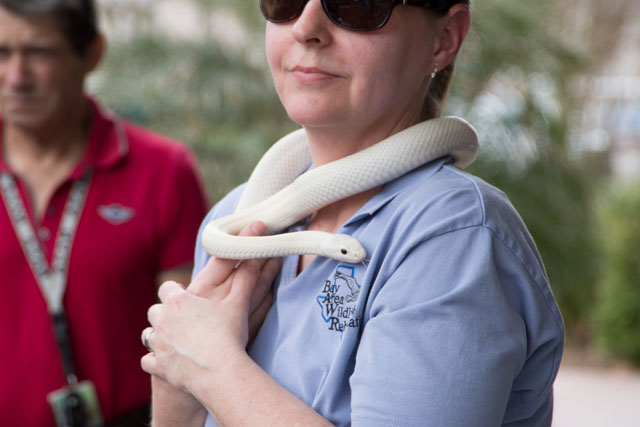Johnson Space Center does give a hoot—about wildlife
On Feb. 2, a crowd gathered outside of Building 11 to watch wildlife rehabilitator Merrell Skipper reveal an Eastern Screech Owl, Red-Tailed Hawk and two snakes. Skipper, an expert in birds of prey, has been a certified rehabilitator for the past 16 years. She has also been at NASA Johnson Space Center for 32 years and currently works as an administrative officer for the Astromaterials Research and Exploration Science Division.
Matt Strausser, who assisted Skipper with the wildlife showcase, has been JSC’s wildlife biologist for the past five years. At this event, they worked together to control the birds while educating the audience about how they were discovered and rehabilitated.
Both the owl and hawk were wild but are now permitted by the U.S. Fish and Wildlife Service for rehabilitative captivity with Bay Area Wildlife Rehabilitation. It is difficult to determine both their ages, because they were not tagged prior to being in the wild. They are shown for educational purposes, and neither bird will ever be capable enough of being released back into the wild. All birds of prey “eat on the wing;” they fly to look for food in water, trees and on the ground. The hawk may hit prey once with its talons, while the owl can catch goshawks in mid-air.
Walker, the Eastern Screech Owl, is a small stocky nocturnal bird about the size of a pint glass. Skipper has had Walker for approximately eight years. Her round wings and pointed ears create a distinctive silhouette. This kind of owl is either mostly gray or reddish brown with a complex pattern of bands and spots that provide great camouflage against tree bark. Its native habit is in forests across North America, east of the Rocky Mountains.
Like most owls, the Eastern Screech Owl is active at night and difficult to spot. Bird watchers tend to only listen for its trills or whinnying song. (Click here to listen to the Eastern Screech Owl’s different calls.) Walker, unfortunately, could not appreciate all the attention she was receiving from the crowd, as she’s blind. The owl is also potentially incapable of raising young. She recently laid an egg in her nest, which rests on an elevated shelf. Startled by her new companion, Walker shoved the egg off of the shelf.
Despite being fully grown, the Eastern Screen Owl is dwarfed by the Red-Tailed Hawk. Common throughout North America, large females are frequently misidentified as eagles. Red-Tailed Hawks tend to fly high above large open spaces, showcasing their broad rounded wings, or perch on treetops and light poles, scouting out their next meal. Falcons have even been used at Ellington Field to keep birds off the runways. (Click here to listen to the Red-Tailed Hawk’s different calls.)
Unlike Walker, Skyler, this Red-Tailed Hawk, was very anxious to be out of her flight cage and surrounded by so many curious people. Skipper’s had Skyler for a little over six months after she was originally found in the woods with a broken wing. The rehabilitator believes Skyler flew into a tree. Since the wing cannot be fully healed, Skyler is permanently handicapped—but that doesn’t stop her from getting around. She can still leap about 10 feet high. Strausser worked hard to carefully hold Skyler during the showcase, but she continually tried to break free of her perch. Other birds visible on-site include Red-Shouldered Hawks, Osprey and Caracara.
Skipper also brought out two snakes for JSC team members to observe: a leucistic rat snake and Texas corn snake. The rat snake does not have one of the proteins needed to produce melanin for skin pigmentation, so it is colored white—a condition called leucism. This is actually not a rare condition: one in 50 rat snakes are leucistic.
The Texas corn snake is a mix of a red and brown rat snake, and are opportunists when it comes to eating. They tend to eat more than 50 rats or mice throughout one year, while other snake species will eat 10 to 15. Rat snakes are known to climb rafters to eat pigeon eggs and venomous snakes on the ground. Exterminators will use them in homes to get rid of pest problems. From a human perspective, rat snakes are good to have around to control rodent and venomous snake populations.
Skipper and Strausser are two experts at JSC with a passion for wildlife, these birds and land conservation. They have worked in coordination with many organizations at JSC to preserve the habitats of Texas wildlife species on-site and would love to tell you more about the amazing creatures that call JSC home.
For questions, please contact the Environmental or Sustainability Offices on-site.
Eric Smith
NASA Johnson Space Center











